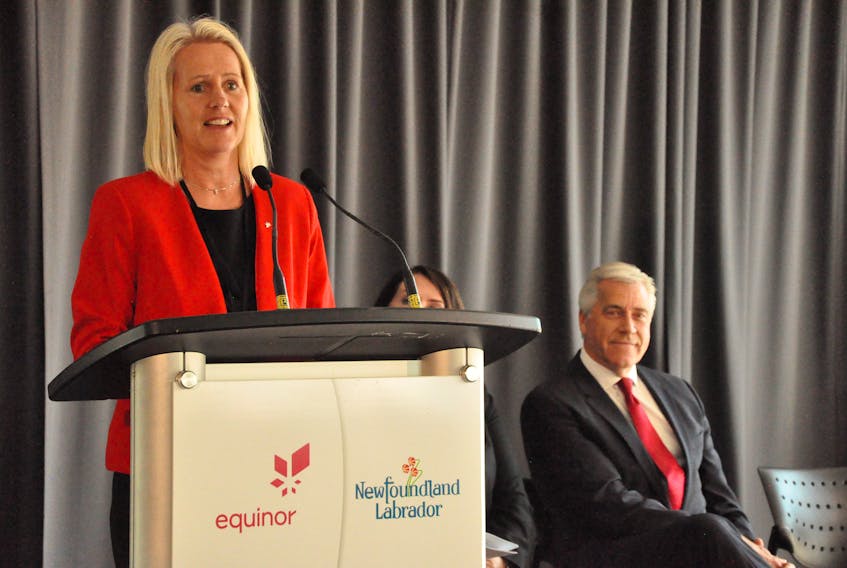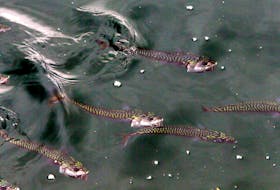There’s no guarantee that Equinor will proceed with its Bay du Nord project, but if it does, a framework agreement with the provincial government is in place.
The agreement, announced Thursday morning in St. John’s, will see a $6.8-billion investment in the predevelopment and development phase, $3.4 billion of which will be spent in Newfoundland and Labrador.
Total project cost, including the operations phase, is tabbed at $10.9 billion.
The provincial government, through Nalcor Energy’s Oil and Gas division, is spending nearly $90 million to purchase a 10 per cent interest in the deep-water project.
Premier Dwight Ball confirmed the province would end up borrowing money to fund its equity purchase and its share of subsequent project spending henceforth, but the possibility of a return between $800 million and $1 billion makes it worth it.
“I think every single person in our province would expect us to make that investment on their behalf,” Ball told reporters.
“The rate of return on this $90 million … will bring significant and tremendous benefits to the people of our province.”
Related story:
Equinor files description for Bay du Nord; anticipates first oil from Newfoundland offshore project by mid-2020s pending investment decision
Estimated revenues over the anticipated 12 to 20 years life of the reserve are $3.5 billion, the bulk of which will come from royalties under the new Generic Oil Royalty Regulations that came into effect last fall. The province’s equity is expected to account for the second-largest portion revenue, with taxes making up the rest.
The project is expected to create more than $14 billion in economic activity within the province.
Project sanctioning is anticipated in 2020, with first oil by 2025. This represents a 12-year turnaround from discovery to production. By comparison, Hibernia took 25 years.
In terms of employment benefits in this province, officials spoke in terms of person hours of employment, suggesting that 22.3 million person hours (11,000 person years) during the predevelopment, development and operations phase.
In an effort to put a more tangible number on employment, officials from Equinor estimate there will be 500 jobs a year for 12 to 15 years during the operations phase.
Equinor suggests there’ll be a 70-person rotation aboard the new, more modern and lightweight floating production, storage and offloading (FPSO) vessel that will be built for the job, one similar to a vessel the company is building for its Johan Castberg project in the Barents Sea off Norway’s coast.
If that seems like a small number for a project of this magnitude, it’s because a good portion of day-to-day work will be handled from an onshore integrated operations centre that will house up to 50 employees.
Unlike previous oil and gas projects in the province’s offshore, where fabrication contracts were awarded on a module-by-module basis, the agreement with Equinor deals in terms of metric tonnes, with 5,000 guaranteed for the province within a competitive bid framework.
Fabrication of the FPSO’s hull, turret, flowlines, umbilicals and other components will be contracted internationally, since the capacity for such work doesn’t yet exist in the province.
That said, Equinor has committed to increasing local fabrication capabilities by purchasing a large-scale steel roller that the winning bidder on the suction anchor moorings contract will use for this project and keep after it wraps up, thereby creating a legacy piece that can be used for the fabrication of future tiebacks to nearby discoveries and to bid on global contracts.
The agreement also includes $75 million over 10 years for research and development, and education and training to help position the province as a centre of excellence for deep-water oil and gas operations.
Ball says the framework agreement and potential for development at deep-water sites positions the province as a global leader.
“There's no doubt once you get companies like Equinor and Husky out there with this discovery producing oil, this will attract others in the industry as well.”
Discovered in 2013 and holding a reserve of nearly 300 million barrels of oil, Bay du Nord would be the first in the Flemish Pass Basin — located 500 kilometres east of St. John’s — and the most remote offshore oil and gas project in the world.
If it proceeds, it will be, by far, the deepest project in the province’s offshore sector, at nearly 1,200 metres. By comparison, Husky’s White Rose project is currently the deepest, drilling at a depth of 120 metres.
Unni Fjaer, Equinor Canada’s vice-president of offshore Newfoundland, acknowledged the challenges of operating in a distant and harsh environment and in deep water, but said the company has experience to tackle those challenges.
“This is technology that Equinor has developed through many years of operations in the subsea, so this is tech we know today,” Fjaer said.
“I'm sure that with good collaboration, both with the government and the supply industry in this area, we will find the solutions.”
In a technical briefing ahead of the announcement, government officials from the Department of Natural Resources stated that the break even price for this project is $49 per barrel of oil, but a spokesperson for Equinor noted this is a government evaluative figure, not an Equinor number, as that is both confidential and commercially sensitive.
When asked what Equinor’s number might be when determining a go or no-go on investment, Fjaer declined comment.
Twitter: kennoliver79









